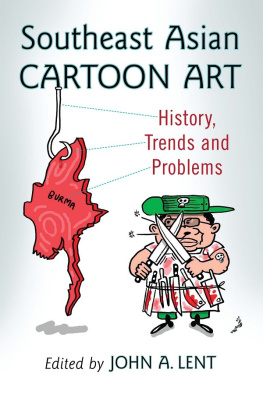Southeast Asian Cartoon Art
History, Trends and Problems
Edited by John A. Lent

McFarland & Company, Inc., Publishers
Jefferson, North Carolina
LIBRARY OF CONGRESS CATALOGUING DATA ARE AVAILABLE
BRITISH LIBRARY CATALOGUING DATA ARE AVAILABLE
e-ISBN: 978-1-4766-1446-5
2014 John A Lent. All rights reserved
No part of this book may be reproduced or transmitted in any form or by any means, electronic or mechanical, including photocopying or recording, or by any information storage and retrieval system, without permission in writing from the publisher.
On the cover: Butcher of Burma, editorial cartoon by Stephff, October 2, 2007
McFarland & Company, Inc., Publishers
Box 611, Jefferson, North Carolina 28640
www.mcfarlandpub.com
Preface
JOHN A. LENT
Cartoon art in Southeast Asia has been building a good reputation for many years, though it is little studied. For example, King Bhumibol Adulyadej of Thailand selected famous cartoonist Chai Rachawat to illustrate two books His Majesty wrote. The comics character Mr. Kiasu (created by Johnny Lau) fosters a Singaporean national trait called kiasuism (the need to be first). In Malaysia, the humor magazine Gila Gila for a long time topped the countrys most circulated periodical list. In the Philippines, komiks, almost since their inception, served as the source of nearly one half of Pilipino feature film plots and as a main vehicle for social consciousness messages. In Indonesia and the Philippines, a form of graphic novel existed decades before this type of book became popular in the West.
With these and other notable accomplishments, one must wonder why Southeast Asian cartooning has been such a well-kept secret. There are a few possible answers. First, the importance given to American superhero comic books and Japanese manga left no room for a serious consideration of the local product. Second, in almost every Southeast Asian country, governments and the public did not think of comic strips and comic books as anything other than childrens entertainment. Third, academia, nurtured by strong colonial influences as to what should be studied, snobbishly ignored comic art.
Despite these oversights, cartooning in Southeast Asia has had a long reach and a profound impact on the regions societies. Humor magazines appeared in the Philippines in the late nineteenth century; political cartoons and comic strips in some countries by the early twentieth century; and comic books after World War II. Although strong authoritarian governments were in power from time to time in each of the countries studied here, political cartoonists managed to leave their venom, usually covertly, which occasionally led to arrest, imprisonment, and other harassments. Comic books faced different problems, usually economic, but they experienced a heyday in the 1960s through the 1980s in Cambodia, Indonesia, the Philippines, and Thailand. Humor magazines thrived in Malaysia, particularly after 1978.
Almost simultaneously, at the end of the twentieth century, comic art forms suffered setbacks throughout the region: pressure from governments and corporations to stifle political cartooning; severe competition from comic strips and comic books produced in the U.S. and Japan; and new media such as television and the Internet. For myriad reasons, the comic book industry in Southeast Asia was all but buried as the 1990s approached. And then, because of the yeomen efforts of a few cartoonists and cartooning aficionados, comic books made a comeback beginning in the mid to late 1990s. In a number of instances, what sparked this renewed interest were independent self-published comics (often crudely produced on photocopiers and distributed non-conventionally) and reprinted classics from the 1960s and 1970s. In more recent years, the Internet allowed for speedier, less-expensive production.
Additionally, other factors led to the rebirth of comic books. Manga, for all the criticisms of them as destroyers of local comics, contributed by regenerating interest in some quarters for what was a dying medium. Observing the global manga phenomenon stimulated local entrepreneurs to enter comics production, a result being that many new companies sprouted, among them Art Square Group in Malaysia; Chuang Yi, M.G. Creative, and Comix Factory in Singapore; Mango Comics, Komikero Publishing, and Sacred Mountain in the Philippines; m&c! Comics and other appendages of the Kompas Gramedia Group in Indonesia; E.Q. Plus, Typhoon Books, and New Venture Generation in Thailand; and Our Books in Cambodia. Other changes since the 1990s are:
1.The moving of sales and distribution from male-only-friendly comics shops and roadside stalls to comics and Internet cafes, comic shops, and large retail bookstores attractive to both male and female readers.
2.The demise of some genres (e.g., Philippine nobelas) and the rise of others such as graphic novels (e.g., E.Q. Plus Publishings series of Knowledge Comic in Thailand; Gerry Alanguilans Elmer and Budjette Tans Trese: Murder on Balete Drive in the Philippines; Yuniartos Garudayana in Indonesia; or Sras Impasse et Rouge in Cambodia) and underground and alternative comics (Athonks The Bad Times Story and others in Indonesia; the Hesheit series in Thailand).
3.Adaptations and spin-offs of comics, such as komiks movies again in the Philippines, and television animation adaptations (e.g., Lats Kampung Boy in Malaysia and Pang Pond in Thailand).
4.The changing role of women with an increase in their readership of comics because of Japanese girls (shoujo) and yaoi (boy to boy love) manga; more attractive rental/sales venues; female-friendly content (Cabai, a Malaysian humor magazine exclusively for women, Azisa Noors Satu Atap [One Roof] in Indonesia and Mango Jam in the Philippines); and more women practitioners (in Indonesia, most young comics artists are women working for books published by ElexMedia Komputindo).
Newspaper comic strips do not seem to have changed much in recent years. In the Philippines and Indonesia, major dailies still carry a rather large assortment of local strips in the national language, while in Singapore and Malaysia, one finds a mixture of a few local and foreign syndicated strips. Except on Sunday, when color sections of U.S. strips appear, usually Thai dailies each have one or two local funnies (sometimes political). Comic strips are rare in Cambodian and Vietnamese newspapers. The limited growth of Southeast Asian newspaper strips is attributable to economics (it is less expensive to use syndicated foreign strips), government and social pressures, and lessened importance of newspapers in light of the emergence of the Internet.
Political cartooning, as always, depends upon the type of government in power. In Cambodia, Myanmar, Vietnam, and, to lesser degrees, Singapore, Malaysia, and Indonesia, cartoonists are stifled by officialdom in dealing with political issues directly, resorting instead to covering social problems or using subtle means to get political messages across. Thai political cartoonists seem to be the most outspoken, for even historically-free Philippine political cartoonists face the perils of self-censorship brought on by the oligarchic control of the dailies. In some cases, political cartoonists have left their countries, going into exile (as with Myanmar cartoonists working out of Thailand) or seeking more lucrative financial arrangements (as with some Philippine cartoonists who went to Singapore). The latter also applies to comic book artists, particularly some from Cambodia, Indonesia, and the Philippines, who work for U.S., Japanese, and French comics publishers, either in those countries or from their home bases.








